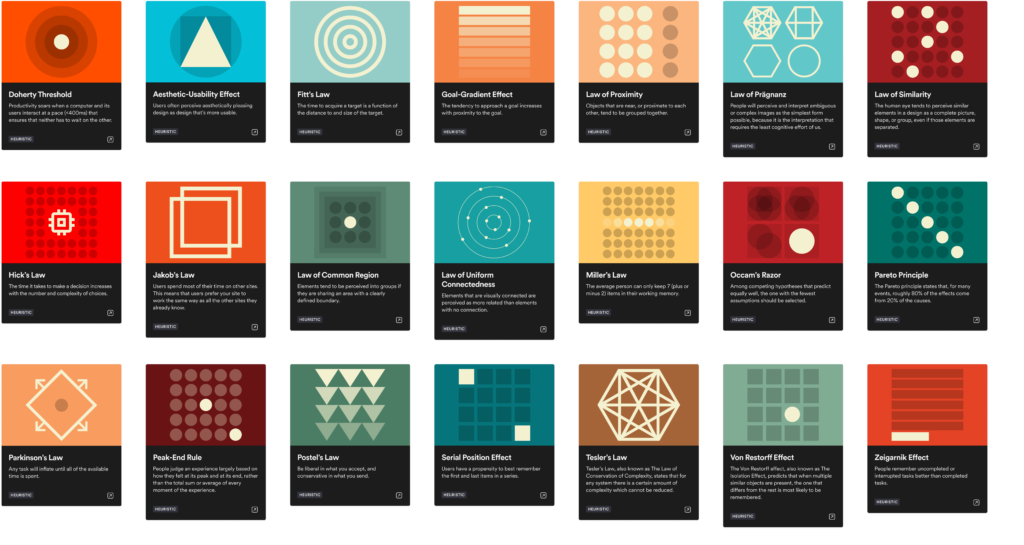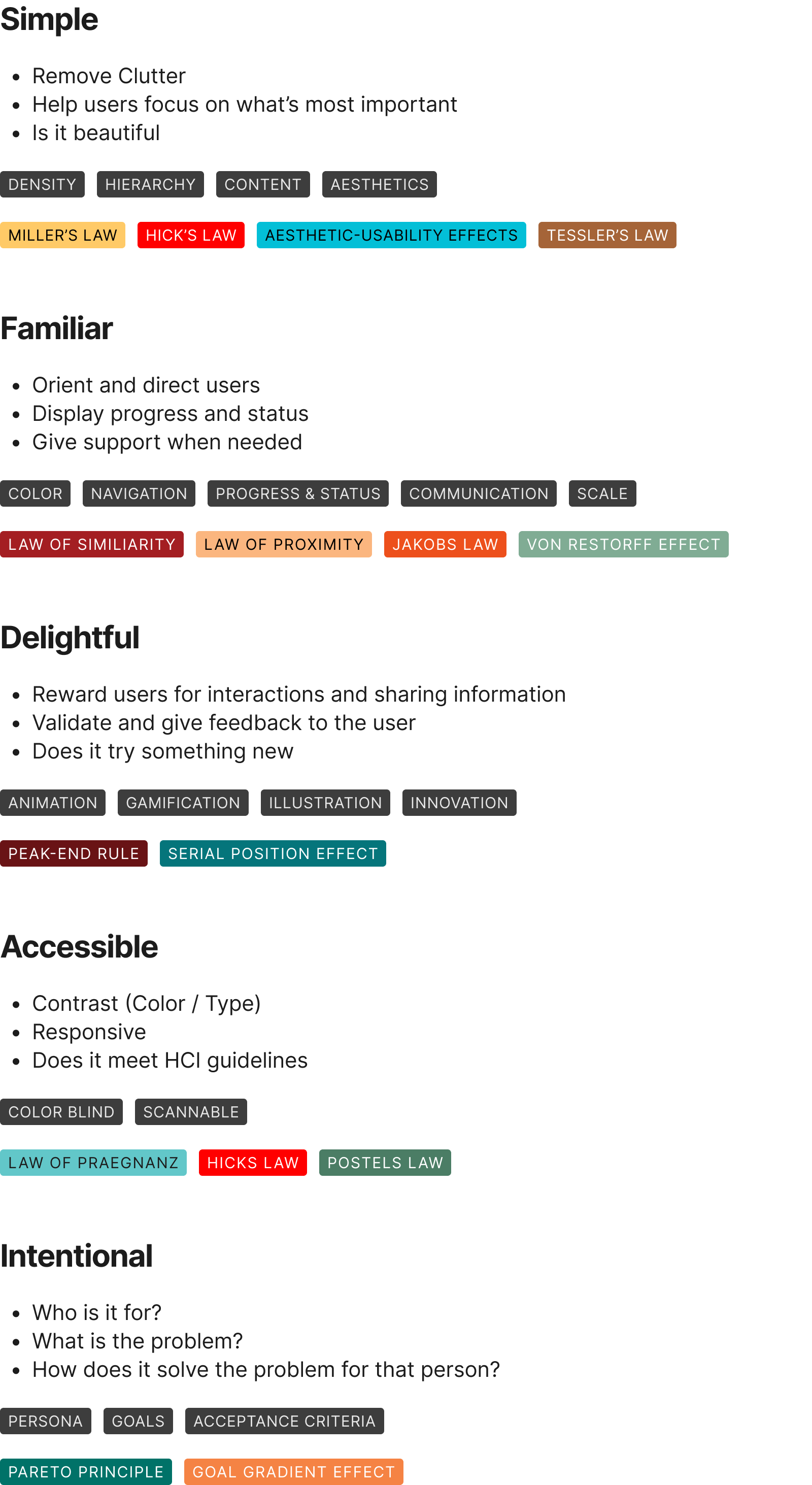In our pursuit of establishing design values for the UX team, we placed a dual emphasis on universal UX principles and our company values—Be The Guide, Sincere Sustainability, and Elevate Everything. This collaborative effort unfolded through a series of workshops, discussions, and exercises where we sought alignment with our organizational ethos.
During this iterative process, our primary focus was on aligning our efforts with the Laws of UX by Jan Yablonski, while staying true to the core values of our company. The journey commenced with a team workshop, underscoring the integration of these dual guiding influences.

Our main objective during the workshop was to explore how our past UX design work not only adhered to but enhanced the universal laws of user experience. Simultaneously, we ensured that our design principles resonated with the values encapsulated by our company—Being The Guide, embodying Sincere Sustainability, and striving to Elevate Everything.
As we brainstormed guiding principles, we prioritized those that not only aligned with universal UX laws but also harmonized with our company values. This approach ensured that our design decisions were not only user-centric but also reflected our commitment to being guides, practicing sincere sustainability, and consistently seeking to elevate every aspect of our work.
Reflecting on past projects went beyond learning from experience; it was also about evaluating how well our designs aligned with both universal UX principles and our company’s values. This retrospective analysis ensured that our design values were rooted not only in the lessons learned from past projects but also in our commitment to being guides, practicing sincere sustainability, and striving to elevate every design endeavor.
During the user persona workshop, we wove together insights into user needs and preferences with a keen understanding of universal UX principles. Simultaneously, we ensured that our user-centric approach aligned seamlessly with our company values—being the guide, practicing sincere sustainability, and striving to elevate every user experience.
Analyzing competitors in UX design wasn’t just about benchmarking against industry practices but also assessing how well these practices aligned with both universal UX principles and our company values. Our focus was on ensuring that our design decisions not only met industry standards but also reflected our commitment to being guides, embodying sincere sustainability, and seeking to elevate every aspect of our designs.
Affinity mapping and drafting statements for our design values were approached with a dual perspective—ensuring clarity and refinement in line with universal UX laws while staying deeply connected to our company values: Be The Guide, Sincere Sustainability, and Elevate Everything.
In the prioritization exercise leading to the final consensus on our design values, we highlighted those that not only enhanced our past UX work but also aligned with the universal laws of user experience and our company values. This dual alignment ensured that our design values were not only effective but also reflective of our commitment to being guides, practicing sincere sustainability, and consistently seeking to elevate everything we did.
As we documented and communicated these design values, we made a conscious effort to illustrate how they linked back to both universal UX principles and our company’s core values. The periodic reviews and iterative refinements weren’t just about staying current; they were about ensuring that our values evolved in tandem with the dynamic landscape of UX and remained in harmony with our commitment to being guides, practicing sincere sustainability, and striving to elevate everything.
In essence, our approach to creating design values was a nuanced blend of adhering to universal UX principles and embodying our company values—Be The Guide, Sincere Sustainability, and Elevate Everything. This alignment ensured that our UX team’s past efforts not only met industry standards but actively contributed to the realization of our company’s overarching mission and values.
The resulting five core design values serve as guiding principles for our UX work:
Simplicity
Aspects: Density, Hierarchy, Content, Aesthetics
Laws: Miller’s Law, Hick’s Law, Aesthetic-Usability Effects, Tessler’s Law
- Have we removed clutter?
- Does the design eliminate unnecessary elements that may distract or confuse users?
- Is there a conscious effort to maintain a clean and straightforward design?
- Does it help users focus on what’s most important?
- Is the hierarchy of information clear, guiding users to prioritize essential elements?
- Does the design facilitate a smooth and focused user journey?
- Is it beautiful?
- Does the design adhere to aesthetic principles that align with our brand and user preferences?
- Is there a balance between simplicity and visual appeal?
Familiarity
Aspects: Color, Navigation, Progress & Status, Communication, Scale
Laws: Von Restorff Effect, Jakob’s Law, Law of Proximity, Law of Similarity
- Do we orient and direct users?
- Is there clear guidance on how users should navigate through the interface?
- Are design elements consistent with established patterns, ensuring a familiar experience?
- Does it display progress and status?
- Is there visual feedback to indicate progress or completion of tasks?
- Does the design provide clear status updates to keep users informed?
- Is support given when needed?
- Are there accessible support features for users who may require assistance?
- Does the design anticipate and address potential user challenges?
Delightful
Aspects: Animation, Gamification, Illustration, Innovation
Laws: Peak-End Rule, Serial Position Effect
- Are users rewarded for interactions and sharing information?
- Does the design incorporate elements that reward user engagement and participation?
- Are there features that encourage users to share information willingly?
- Do we validate and give feedback to the user?
- Is there immediate and constructive feedback for user actions?
- Does the design acknowledge and appreciate user input?
- Does it try something new?
- Is the design open to innovative elements or features that enhance the overall user experience?
- Does it introduce creative solutions that go beyond conventional approaches?
Accessible
Aspects: Colorblind, Scanability, Responsiveness
Laws: Law of Praegnanz, Hick’s Law, Postel’s Law
- Does it meet contrast guidelines (Color / Typography)?
- Is the color contrast within the recommended accessibility guidelines?
- Are typography choices optimized for readability and inclusivity?
- Are the designs responsive?
- Does the design adapt seamlessly to different devices and screen sizes?
- Is the responsiveness of the design prioritized for an inclusive user experience?
- Does it meet HCI guidelines?
- Does the design align with Human-Computer Interaction (HCI) principles for ease of use?
- Are interactive elements designed with consideration for diverse user abilities?
Intentional
Aspects: Persona, Goals, Acceptance Criteria
Laws: Pareto Principle, Goal Gradient Effect
- Who is it for?
- Is the target audience clearly identified and considered in the design process?
- Does the design cater to the specific needs and preferences of the intended users?
- What is the problem we are solving?
- Is there a clear understanding of the user problem or pain point that the design addresses?
- Have we articulated the problem in a way that guides the design decisions?
- How does the design solve the problem for that person?
- Does the design present a solution that directly addresses the identified problem?
- Is the user’s perspective and experience central to the design’s problem-solving approach?
These questions, rooted in our design values, guide our reviews and ensure a consistent commitment to delivering meaningful, user-centric, and aligned experiences.
See our values
